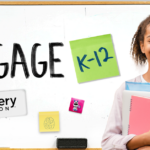By Lindsay Portnoy and Karen Reiss Medwed
As the CDC monitors COVID-19, educational and industry leaders across the globe are asked to prepare for alternative learning options in the event of a domestic pandemic. While this is not the only disruption to traditional schooling, it’s a unique moment in time when large numbers of schools across the nation may experience disruption simultaneously and resources may be few and far between. How is it possible to prepare for learning without disruption?
Equitably meeting the needs of all learners necessitates mindfulness—not only of available resources, but also of the potential burden of accessing those resources. It may also be an opportunity to leverage promising new tools to advance interdisciplinary knowledge through multimodal learning, and perhaps enhance our home-to-school connections in the process.
Case One: Math
In a statistics class, local high school students work from any location to map neighborhood resources within their community ranging from access to grocers to transportation. As they map community resources on Google Maps, patterns emerge that support student responses to questions such as, “What gaps do you see in access to transportation in your community and how might you address them?”
Students use video tools to communicate statistical insights broadly to peers in their classroom or across the globe. Tools like FlipGrid may supplant penpals as communities of learners connect instantly through digital networks. Suddenly, learners can communicate mathematically, sharing statistical data about their unique communities and moreover are able to co-create solutions to pressing, widespread issues through their shared knowledge.
Through a series of intentional prompts, educators transform a course on statistics into an opportunity to engage with learners the world over and see firsthand how data can be used to advocate for more equitable access to essentials like transportation and food sources. Student work leads to conversations about food deserts and helps learners see themselves in the role of others, taking the perspective of those they may not otherwise meet. Together, these students begin to work toward solving similar problems that exist under different names across the globe.
Case Two: History
Using our current situation, students in a history class create an online time capsule to document their lived experiences, connecting the current situation to similar experiences in our shared past. For instance:
- What systems were in place to combat the flu pandemic of 1918 and how do they compare to those in place in 2020?
- What ways have industrialization and commercialization impacted the spread of these viruses?
- How has the nature of our infrastructure as a society changed the way diseases spread?
In seeking answers to questions connecting historical events to events experienced today, learners grow in their ability to have a sense of agency in their learning.
Existing platforms like Google docs allow us to co-create writing, while those such as FlipGrid invite asynchronous responses to prompts that elevate all voices. More exciting is the fact that novel tech tools are emerging each day. These tools will continue to transform and enhance our ability to learn anywhere and at any time. Our role then, is to support learners in discovering these resources and to model the active curation of content as our learners explore, engage, and continue learning on these new platforms.
Instead of simply replacing a lecturing educator with a lecturing educator on video, we’ve seen the intentional integration of multiple free platforms where learners are at the center of curating and co-creating knowledge. What’s more, these new models of learning allow caregivers to gain access to traditionally closed processes of learning. Supporting the home-to-school connection, making learning visible to all, and inviting all community members to become lifelong learners.
Rather than replicate the rote learning that often happens in classrooms, we can offer students ways to make meaning of their lived experience through this time across domains, from science and art to history and language. Thanks to new technologies and approaches, those of us who work in communities and homes with network connections and access to technology can meet virtually and continue to grow and thrive together.
Our next, pressing challenge is to address solutions for our students and teachers whose learning exists outside the privileged pockets of technology access. In dire situations, the worse educational solutions are ones which grow the gaps of systemic inequity and do not attend to the most vulnerable in our midst.
Lindsay Portnoy, Ph.D. is Associate Teaching Professor in the Graduate School of Education of the College of Professional Studies at Northeastern University.
Karen Reiss Medwed, Ph.D. is Assistant Dean of Networks and Digital Engagement of the Graduate School of Education in the College of Professional Studies at Northeastern University and Associate Teaching Professor.
The American Consortium for Equity in Education, publisher of the "Equity & Access" journal, celebrates and connects the educators, associations, community partners and industry leaders who are working to solve problems and create a more equitable environment for historically underserved pre K-12 students throughout the United States.
- American Consortium for Equity in Educationhttps://ace-ed.org/author/admin/
- American Consortium for Equity in Educationhttps://ace-ed.org/author/admin/April 23, 2025
- American Consortium for Equity in Educationhttps://ace-ed.org/author/admin/
- American Consortium for Equity in Educationhttps://ace-ed.org/author/admin/







